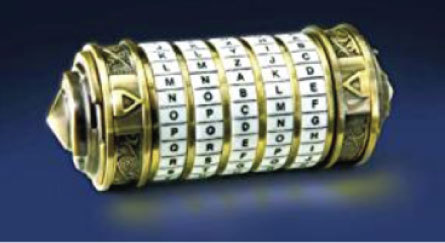Da Vinci Under Lock-and-Key
A good story may raise ideas out of fiction to turn them into fact. Enter, science fiction!
In Dan Brown's suspenseful novel, The Da Vinci Code, a combination lock he dubs a "Cryptex" is poised to secure and protect secrets written on a parchment contained inside a portable vault. The author coined the term by combining the words "cryptography" and "codex," a large volume of ancient texts bound together in book form, like those for which Leonardo is famous.

The Cryptex functions like a bicycle combination lock. Inside the device, discs must be positioned in the exact manner to spell out a correct, preset password. Tumblers inside the lock then align, allowing the inner cylinder to slide apart, protecting the contents in the inner space.
We do know that Leonardo was very concerned about protecting the secrets of his designs and inventions, which is why he developed his now-famous mirror writing, a novel form of encryption that kept many of his design innovations locked from posterity. And we do know that Leonardo loved to pull tricks and riddles on his friends.
In fact, you might want to see if you can solve the Leonardo da Vinci riddle, a famous math sequence based on patterns.
The Da Vinci Code takes that secrecy a step further: the incorrect combination will release a vial of vinegar, destroying the message inside, making it unreadable. Imagine if all of da Vinci's notebooks had been encrypted this way!
While the Cryptex is central to Brown's story, there is no evidence that Leonardo invented anything like this. But as a case of "life imitating art," since its mention in the 2003 blockbuster novel, the Cryptex has become a popular puzzle in-and-of-itself, foiling would-be lock pickers around the globe.
Want to Learn More?
- Brown, Dan. "The Da Vinci Code" Doubleday, 1 Jan, 2003. . Accessed on 12 Apr, 2018.
- Khovanova, Tanya. "Can You Solve the Leonardo Da Vinci Riddle?" TED, TED-Ed, 30 Nov, -0001. https://ed.ted.com/lessons/can-you-solve-the-leonardo-da-vinci-riddle-tanya-khovanova. Accessed on 2 May, 2018.